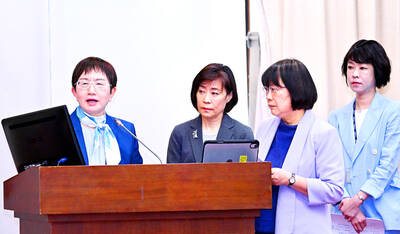E Ink Holdings Inc (元太科技), which supplies e-paper displays for Amazon.com Inc’s Kindle e-reader series, yesterday said it may see losses this quarter and the next one because of weak seasonal demand.
Revenue is expected to fall by between 5 percent and 10 percent from last quarter’s NT$5.86 billion (US$192.4 million), chief financial executive Eddie Chen (陳彥松) told an investors’ conference.
With revenue at such a level, “there is a strong likelihood that E Ink will drift into the red during the first half of the year,” Chen said, citing weak seasonal demand for ebooks.
E Ink posted nearly double quarterly net profit for the last quarter. Net income expanded to NT$1.01 billion last quarter, primarily from royalties income, compared with NT$511 million in the third quarter last year.
E Ink booked NT$820 million in royalties income last quarter. Operating income reached NT$228 million, reversing an operating loss of NT$228 million for the prior quarter.
IMPROVEMENT
The company turned a net profit for last year of NT$29 million — a significant improvement from net losses of NT$749 million in 2012 — thanks to an income tax refund for minority interest, its annual report showed.
“The company is still undergoing a series of corporate restructurings aimed at improving its financial health, and there is a long way to go,” Chen said.
He said E Ink’s South Korean subsidiary, Hydis Technologies Co’s, utilization rate dropped to less than 30 percent last year because of weakening demand for ebook devices.
E Ink plans to broaden its product portfolio this year by including more displays for smartphones, Chen said.
The company began shipping e-paper products to Russian smartphone vendor Yota Devices last quarter, and it will start mass producing electronic price labels or luggage tags this year to further diversify its product mix and increase sales, he said.
E-PAPER DISPLAY
E-paper display was the biggest revenue source for E Ink last year, accounting for more than 80 percent of its revenue of NT$18.9 billion.
Displays only made up 15 percent to 20 percent of revenue.
“E Ink needs to strengthen its non-e-book businesses in order to better its financial performance,” Taipei-based Horizon Securities analyst Stanley Hsu (許家銘) said by telephone.
Hsu said the global ebook device market will no longer be able to achieve high shipment growth due to the rise of tablets, since consumers are able to read ebooks offered by Amazon or Kobo on their tablets.
Citing studies by Horizon Securities, Hsu said shipments of e-book devices reached a peak of 20 million units in 2012 and then fell to 16 million units last year.
As market demand for smartphone remains robust, E Ink should address the underdeveloped e-paper smartphone market “because that is a new niche market,” Hsu said.

‘SWASTICAR’: Tesla CEO Elon Musk’s close association with Donald Trump has prompted opponents to brand him a ‘Nazi’ and resulted in a dramatic drop in sales Demonstrators descended on Tesla Inc dealerships across the US, and in Europe and Canada on Saturday to protest company chief Elon Musk, who has amassed extraordinary power as a top adviser to US President Donald Trump. Waving signs with messages such as “Musk is stealing our money” and “Reclaim our country,” the protests largely took place peacefully following fiery episodes of vandalism on Tesla vehicles, dealerships and other facilities in recent weeks that US officials have denounced as terrorism. Hundreds rallied on Saturday outside the Tesla dealership in Manhattan. Some blasted Musk, the world’s richest man, while others demanded the shuttering of his

TIGHT-LIPPED: UMC said it had no merger plans at the moment, after Nikkei Asia reported that the firm and GlobalFoundries were considering restarting merger talks United Microelectronics Corp (UMC, 聯電), the world’s No. 4 contract chipmaker, yesterday launched a new US$5 billion 12-inch chip factory in Singapore as part of its latest effort to diversify its manufacturing footprint amid growing geopolitical risks. The new factory, adjacent to UMC’s existing Singapore fab in the Pasir Res Wafer Fab Park, is scheduled to enter volume production next year, utilizing mature 22-nanometer and 28-nanometer process technologies, UMC said in a statement. The company plans to invest US$5 billion during the first phase of the new fab, which would have an installed capacity of 30,000 12-inch wafers per month, it said. The

Taiwan’s official purchasing managers’ index (PMI) last month rose 0.2 percentage points to 54.2, in a second consecutive month of expansion, thanks to front-loading demand intended to avoid potential US tariff hikes, the Chung-Hua Institution for Economic Research (CIER, 中華經濟研究院) said yesterday. While short-term demand appeared robust, uncertainties rose due to US President Donald Trump’s unpredictable trade policy, CIER president Lien Hsien-ming (連賢明) told a news conference in Taipei. Taiwan’s economy this year would be characterized by high-level fluctuations and the volatility would be wilder than most expect, Lien said Demand for electronics, particularly semiconductors, continues to benefit from US technology giants’ effort

Minister of Finance Chuang Tsui-yun (莊翠雲) yesterday told lawmakers that she “would not speculate,” but a “response plan” has been prepared in case Taiwan is targeted by US President Donald Trump’s reciprocal tariffs, which are to be announced on Wednesday next week. The Trump administration, including US Secretary of the Treasury Scott Bessent, has said that much of the proposed reciprocal tariffs would focus on the 15 countries that have the highest trade surpluses with the US. Bessent has referred to those countries as the “dirty 15,” but has not named them. Last year, Taiwan’s US$73.9 billion trade surplus with the US